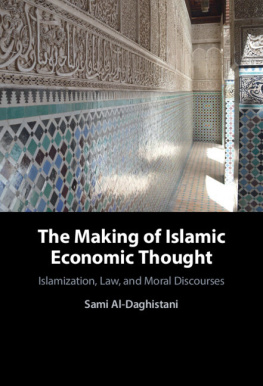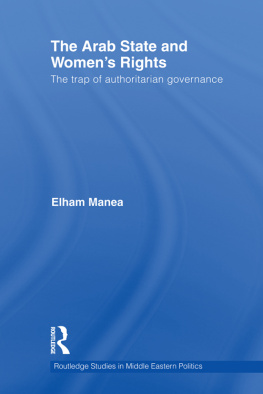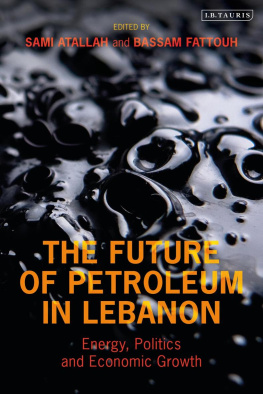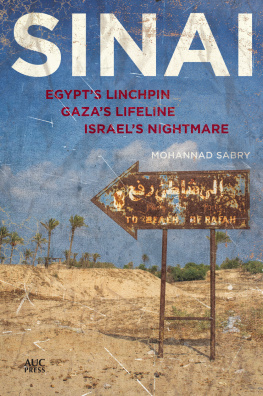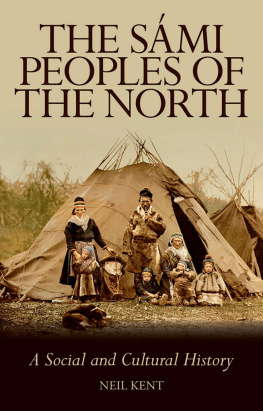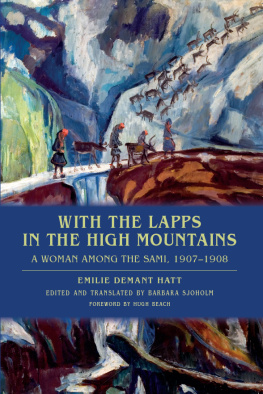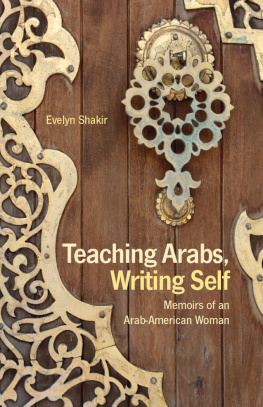Somaya Sami Sabry has a PhD from the University of Western Ontario, Canada. She specialises in Arab-American womens writing and performance as well as race and diaspora studies, and is the recipient of a Fulbright pre-doctoral scholarship (2005).

Published in 2011 by I.B.Tauris & Co Ltd
6 Salem Road, London W2 4BU
175 Fifth Avenue, New York NY 10010
www.ibtauris.com
Distributed in the United States and Canada Exclusively by Palgrave Macmillan
175 Fifth Avenue, New York NY 10010
Copyright 2011 Somaya Sami Sabry
The right of Somaya Sami Sabry to be identified as the author of this work has been asserted by the author in accordance with the Copyright, Designs and Patent Act 1988.
All rights reserved. Except for brief quotations in a review, this book, or any part thereof, may not be reproduced, stored in or introduced into a retrieval system, or transmitted, in any form or by any means, electronic, mechanical, photocopying, recording, or otherwise, without the prior written permission of the publisher.
International Library of Cultural Studies 19
ISBN: 978 1 84885 568 7
eISBN: 978 0 85773 162 3
A full CIP record for this book is available from the British Library
A full CIP record for this book is available from the Library of Congress
Library of Congress catalog card: available
To Walid, Nouran and Roaa
Where we live in the world
is never one place. Our hearts,
those dogged mirrors, keep flashing us
moons before we are ready for them.
Naomi Shihab Nye,
My grandmother in the Stars,
19 Varieties of Gazelle
Preface
Within the current world politics of increasing polarisation, this book defines itself as an interventionist attempt at reconsidering simplistic identity politics through an exploration of diasporic identities. It seeks to position itself in relation to the budding field of Arab-American Studies, through the captivating narrative and orality of the narrator of The Thousand and One Nights, Sheherazade, in Arab-American womens writing and performance. It is important to note here that the very choice of the use of the title Arabian Nights in the title of this book while throughout the text I insist on referring to it as One Thousand and One Nights is a conscious resistant attempt on my behalf to challenge nineteenth century rooted stereotypical representations which seek to portray these tales only as an ethnographical account through which the West can construct all Eastern people.
Sheherazades orality, which once mesmerised a bloodthirsty king, resurfaces on the shores of America translating her story into a different dialect after she has crossed the Atlantic and landed in the new world. This book navigates the intersections of Orientalist and stereotypical racial discourses with which Arab-American women writers and performers contend as members of the Arab diaspora, and how they engage with them to contest and redefine their premises in new ways. Consequently, in the race over representation which these women are running against a history of vilification and dehumanisation, they are beckoned in a race over race, in which they transfigure and disrupt prevalent representations of themselves and their Arab culture. This racialisation is further convoluted by the Iraqi war, the war on terror and violence against Arabs, Muslims and Arab-Americans post-9/11. Because the Oriental woman has always represented a particularly disputed space in representations of the Other, she unfortunately becomes the arena upon which many presumptions about the East are mapped out. These contemporary Arab-American women writers and performers re-situate Sheherazades narrative and orality with the aim of navigating their affiliations and challenging any attempts to simplistically stabilise them; opting, in my opinion, for a more historically situated understanding of identity politics.
This is why my research in this book seeks to address the following questions: how do genres such as the novel, poetry and performances like one-woman shows and stand-up comedy negotiate affiliations in the current polarised and historical moment? How do Arab-American women writers and performers recast Sheherazade, and how is recasting troubled by the exoticised/oppressed representations of Arab and Muslim women in early translations of the frame tale of The Nights and American popular culture? Through close readings and critical analyses of texts and performances, I argue that writers like Diana Abu-Jaber and Mohja Kahf and performers like Laila Farah and Maysoon Zayid offer a fecund area for the examination of identities and representations, shaping a location for cultural translation through their writings and performances. The boundaries and limits of cultural translation are explored through an analysis of Sheherazadian narrative and its adaptation to cultural translation in Crescent and E-Mails from Scheherazad. In Living in the Hyphen-Nation and Maysoon Zayids stand-up comedy routine, Sheherazades blatant orality is examined within the context of being a conduit for cultural negotiations. Through an assortment of artistic forms such as the novel, poetry, one-woman shows and stand-up comedy, these artists remould their identities in relation to a dispersed spectrum of Arab-American identities, so that Sheherazade is reinvented through her crossing of the Atlantic in the context of a historically and politically inflected situatedness in the USA.
Sheherazade in the West:
Sheherazadian narrative as a Dihliz in the Diaspora
For Arab-American women writers and performers, the hyphen in Arab-American is currently a particularly contested zone due to a resurgence of Orientalist and stereotypical racial discourses on Arabs. This racing is further complicated by being shaped against the backdrop of the Iraqi war, the war on terror and hostility against Arabs, Muslims and Arab-Americans post-9/11. In referring to Arab-American women writers and performers, then, one should be aware of the contention surrounding the term Arab since it suggests a constructed unity that in reality crosses multiple geographical and social boundaries. In reality, the term Arab refers to a diverse group of people of varied languages, religions, ethnicities and national identifications.
The aim of this book is to assay the cultural productions of this multiplicity of Arab-American women writers and performers, discerning attempts to refashion it in works of cultural significance like The Thousand and One Nights. In light of this, the recasting of the frame narrative of The Nights does not merely commemorate, but also questions the politics involved in translating collective cultural productions. I consciously make the choice to refer to writers and performers as Arabs, because of my governing concern with their reinterpretation of The Thousand and One Nights as a cultural production of the Arabic language, with special emphasis upon Sheherazade, the storyteller and narrator of The Nights. In view of the above, the main concerns of this book revolve around the politics that shape representation.
The London Tate Museums 2008 Symposium Orientalism Revisited: Art and the Politics of Representation revived key questions regarding art, politics and representation from the nineteenth century to the present. In the introduction to the Symposiums catalogue and her essay in the anthology on the exhibition, Rana Kabbani questions the celebratory tone of Orientalist art exhibitions. She relates the past of Orientalism to its resurgent present, foregrounding the irony involved in the resurrection of the artistic remains of a colonial age which referred to the nineteenth-century occupation of Egypt as an act of civilisation. She also calls into question the present resuscitation of Orientalism, in the imperialist spin that, at least initially, accompanied the Anglo-American action in Iraq; she raises the key question, [i]f the British military occupation of Egypt inspired some of the striking paintings in this exhibition, what images might future generations retain of the present-day occupation of Iraq (Kabbani 2008: 40). The fact that the Tate chose to revisit this topic as recently as 2008 demonstrates the validity of reconsidering Orientalism in relation to current vital issues shaping our globalised world, such as race and diaspora.



